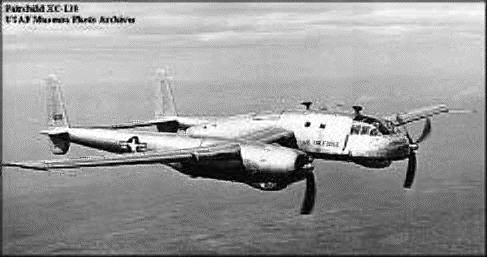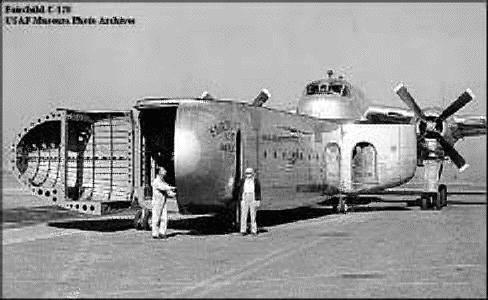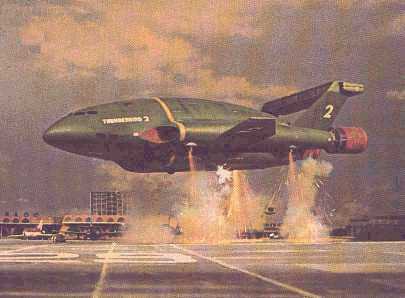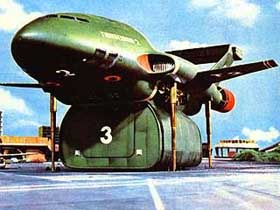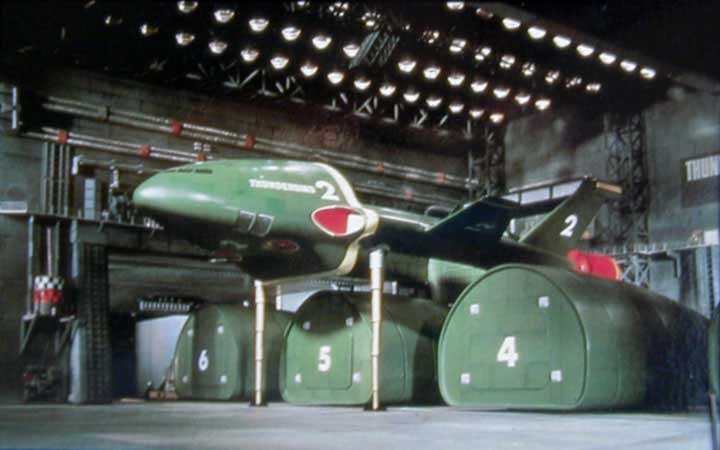"Imagination is more important than knowledge"
--Albert Einstein

1962.
The Cuban missile crisis, JFK, James Bond premiered in "From Russia with Love". The Cold War. Cars still had tail fins. And Boeing Vertol using concepts by Frank Piasecki created the CH-47 Chinook twin-rotor helicopter. The CH-47D is the current model in the Army's conventional forces inventory. There is an advanced MH-47E model that is designed to support special operations. The Army acquired the CH-47 on or about 1963. Boeing Vertol developed the tandem rotor from earlier designs built by legendary Frank Piasecki whose company built the earlier "banana" tandem design known as the CH-21 used in the early days of the Vietnam war.
The CH-47 is still offered to commercial markets but its high maintenance cost stemming from the numerous transmissions associated with the tandem rotor concept has limited its market share.
The CH-47 has enjoyed relatively good success in the world's military markets where the aircraft's advantages in center-of-gravity limits, rear ramp area loading, excellent speed and load-to-horse-power ratio makes it the star performer in high altitude Afghanistan and more than compensates for the high maintenance cost of a 2-rotor aircraft.
The CH-47D model in the Army were mainly rebuilt "Super C models" and are already about 10 years old! The Army is attempting to execute a service life extension program (SLEP) that will for the third time upgrade rotor hubs, engines and flight control systems. This program has not started yet and will probably extend the life of the current 435 aircraft fleet to about 2015-2020.
There is a movement afoot to begin design work on the CH-47's replacement. Several proposals have been floated by the Army After Next (AAN) office from Fort Monroe VA.
The Army will probably not make a decision until 2004-2005. [2012 EDITOR: the do-nothing-waste-maximum-money Army bureaucracy as usual is still playing around with BS "studies" when they should be tangibly upgrading our CH-47s into Super Chinooks.]
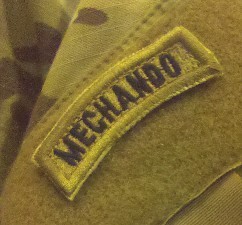
We are hoping the Army will see the light that 21st century maneuver doctrine needs to evolve to AIRmechanization using MECHanized commANDO (MECHANDO) tactics. This would require ultimately replacing or upgrading our Chinooks and Blackhawks with a 250+ knot self-deployable, rotor-wing aircraft capable of delivering Light Infantry or Cavalry Brigade Combat Teams with 15-ton+ armored vehicles and scores of smaller under 7-ton Wiesel or Bv206S AFVs or 4-roadwheel M113 "Mini-Gavins" to decisively 3D maneuver on enemies and defeat them. Its a given that this aircraft should be able to carry 2 or more 4x4 HMMWVs inside EASILY; something the V-22 cannot even carry one.
The recent discovery from NAVAIR combat developer George Spangenberg that in the '70s we almost had a 18-20 ton three-engined CH-54/53E SkyCrane heavy lifter for the USMC to self-recover other CH-53Ds and for the Army to lift ISO containers and light tanks is troubling. The Army insisted on an overly large XCH-62 SkyCrane derived from the tandem-rotor Chinook that could lift the then 22.5 ton Mechanized Infantry Combat Vehicle (MICV); the overweight precursor to the bloated Bradley Fighting Vehicle.
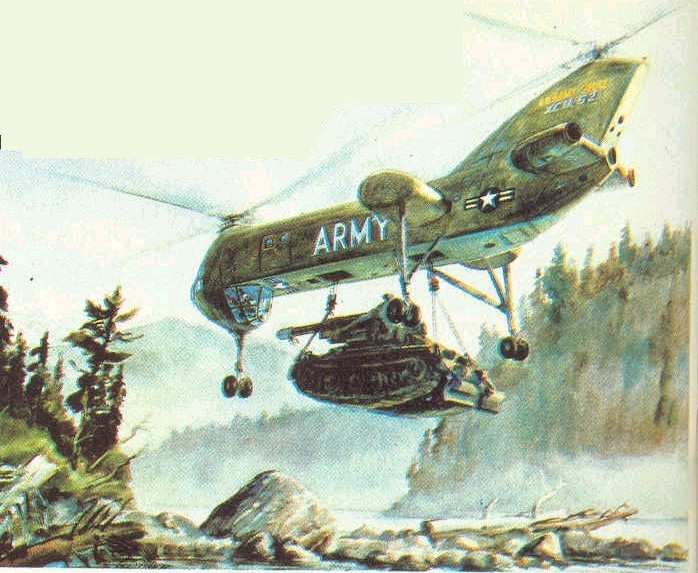
Artist's conception of an Army HLH lifting a 175mm Self-Propelled Howitzer (SPH) whose long-range fires were necessary to keep Vietnam FireBases (today we call them FOBs) viable against long-range NVA 130mm fires so as to prevent another Dien Bien Phu
The XCH-62 was far too big for naval use aboard ships--so the marines stupidly added the 3 engines to the narrow CH-53D fuselage losing 2 tons of lift--and being unable to roll on/off light tracked (tanks) AFVs like the M113 Gavin. The XCH-62 was cancelled so the Army lost the ability to carry light tracked AFVs, ISO containers without sling-loading that reduces air speed and is inherently dangerous. Thus, the as-is CH-47 would have to soldier on. The CH-54 SkyCrane though able to carry 20 tons if fitted with more powerful engines/rotors left Army service--but fortunately Erickson AirCrane has all the design rights and is now making NEW S-64F SkyCranes for fire fighting. Today, DoD is excited about "sea basing"--but doesn't have a 20-ton heavy lifter to enable light tracked AFVs and ISO "Battle Boxes" to come ashore in a timely manner.
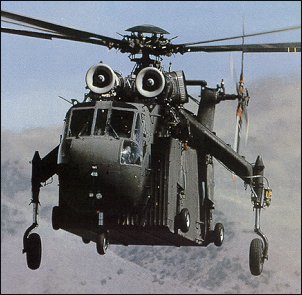
SkyCrane carrying an ISO Container
 www.youtube.com/watch?v=RAltpRp06Uk
www.youtube.com/watch?v=RAltpRp06Uk
Fiddler's Green reports:
fiddlersgreen.net/AC/aircraft/Sikorsky-SkyCrane/info/sketch-ref.jpg
The Sky Crane was a most noteworthy program for the Army as it was desperately needed to off-load container ships in 'Nam; since "Nam" has no deep water ports to accommodate large freighters.Other research has found that the U.S. Army's CH-54 Tarhe ("SkyCrane") heavy-lift helicopter's universal cargo pods also proved very useful, for they could be used to carry up to 87 troops in addition to serving as mobile hospitals, command posts or barracks.
If the Army were smart, its next Chinook should be a Piasecki SpeedCrane type helicopter that can transport ISO container "Battle Boxes".
Details: combatreform.org/nextchinook.htm
NEW! Maisto Press Release: Die-Cast Metal CH-54 SkyCrane Model

Order Online
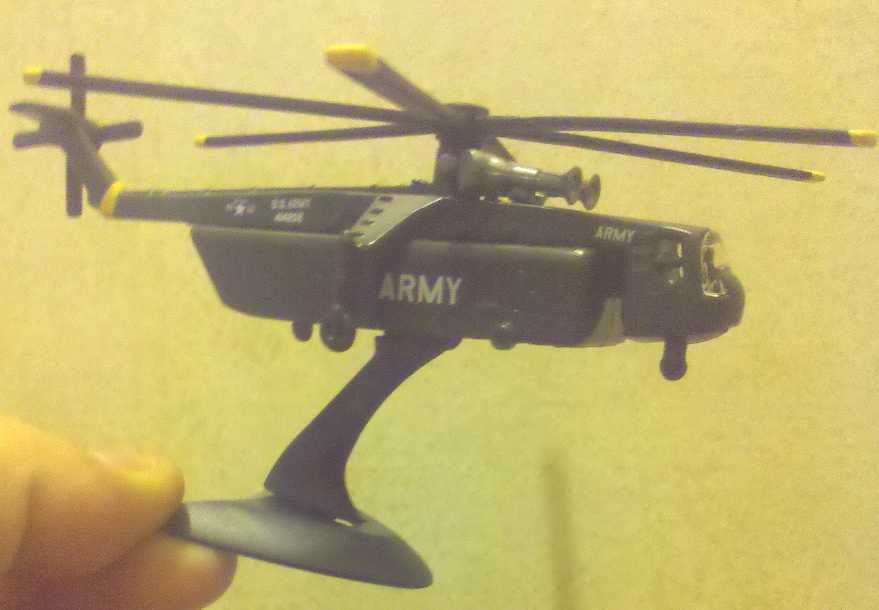
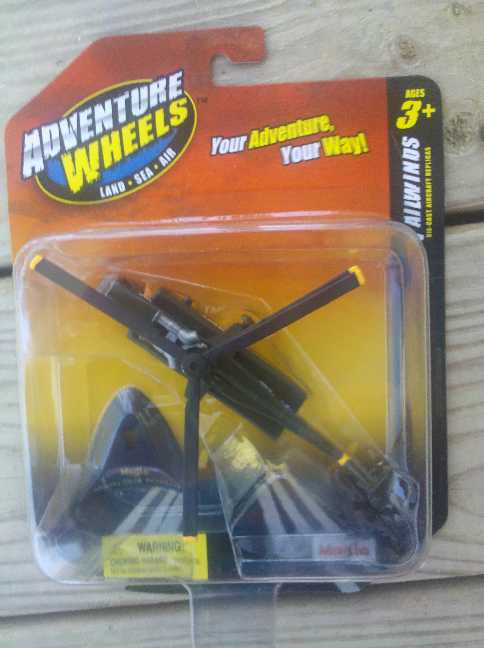
www.toyplanesforsale.com/helicopter-sikorsky/
Even a Mike Sparks-Hater Admits the SkyCrane & BATTLEBOX Concept is the way-to-go:
Historical Discovery Below from Naval Aircraft Combat Developer, George Spangenberg.
Our observations:
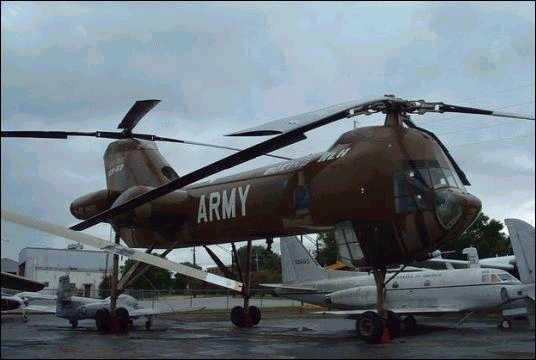
If the Army was not so foolish wanting 22 tons for the XCH-62 Heavy Lift Helicopter (HLH) to lift the MICV (the early version of the now 33-ton Bradley) we could have had a SkyCrane that could lift 18 tons to lift M113 Gavins EASILY or the heaviest 40 foot ISO Container Battle Boxes. Carry people in a pod; what's the mental block here?
We think the Army is going to make the same mistake with the 20-25 ton FCS/GCV/whatever that needs a non-existent FTR/JTR/HLH with a huge fuselage. At the end of the day, we might have another BS medium-weight ground vehicle--but with no V/TOL or ESTOL aircraft to fly it. Not enough money even in the U.S. of A.
We need to stop trying to lift ground vehicles that are too heavy and make the light tanks we have more combat capable (multiple armor layers, v-hull shaping, band tracks, 1-man autocannon turrets etc.) and fly them with EXISTING AIRCRAFT for our 3D forces and use the heavier vehicles for 2D maneuver forces. Two basic forms of maneuver for the open and closed terrain types we find on Planet Earth.
The CH-47F has progressed to where it can carry the 10.5 ton M113A3 Gavin for short distances (about 50 miles) under-slung. Good, but not good enough--light tanks need to be internally or tightly carried against the fuselage for minimal drag so the aircraft can fly at maximum flight performance to evade the enemy. We think we should take the CH-53E's 3-engines and splice them to a SkyCrane so we can lift the 17-ton M8 Buford AGS light tank as well as ISO containerize the entire U.S. Army to get it out of its garrison doldrums and be packed and ready-for-war at all times. The SkyCrane configuration eliminates the sling-load swinging and 100 mph speed restrictions that happens when you can't load the M113 Gavin or M8 Buford into the CH-53E's fuselage. We could make the fuselage bigger--but then you lose 2 tons of payload and can't lift ISO Battle Boxes except by external sling loading.
SO GET RID OF THE FUSELAGE!

http://216.239.41.104/search?q=cache:Sm5mQ84_5-YJ:www.georgespangenberg.com/history2.htm+convair+p6y&hl=en&ie=UTF-8
George Spangenberg:
The next program that also is not on the chart is the CH-53E and that's because it didn't get started until after the chart was drawn, and also an HLH which also would not have been on there because it turned out to be an Army program. The whole effort really started when they deployed the CH-53A which you will remember was started in '63, flew in '64 and then deployed in early '67 to Vietnam. When it reached Vietnam the marines found that they had a problem, they had so few of these helicopters available to them and if one went down in enemy territory they could not retrieve it. The other helicopters, CH-46 for example, could be picked up either by the Army Chinooks or the 'Cranes, CH-54, or by the H-53s and brought back. It apparently became a severe enough problem that the marines got together and came up with a requirement for a crane-type helicopter with self-retrieval capability. In other words, if one went down a similar helicopter could go in and pick it up. The marines were really working quite closely with Sikorsky at the time and Sikorsky then came up with a study for a modification of the CH-53 in which they added a seventh blade, increased the rotor diameter from 72 to 81 feet, added a third engine of the same type as the other two and went to a crane-type configuration similar to the CH-54 which was also one of their designs, of course. At the time it was estimated that configuration would give a lift capability of about eighteen tons and that became really the selling point for the program. NAVAIR was willing to buy the design. In other words, if performance and the weights were agreed upon, we wanted to buy it on a directed procurement. However, the ASN (R&D) decided that we should have a competition and let other manufacturers bid. The program then ran into budget problems. The crane configuration of course was a pretty specialized one and eventually when everyone finally got together on the specification requirements, a conventional fuselage on the helicopter was required. We ended up losing a couple tons worth of lift capability when we did that so the helicopters that resulted were more like a 16 ton lift capacity.We had proposals from Sikorsky, Vertol and Hughes, that I remember, perhaps there were others too. The Hughes was the least attractive of the three proposals. Vertol submitted a version of the Chinook. The Chinook was always a competitor for the CH-53 but the height of the helicopter was enough so that Vertol never did get around to really working out an arrangement where it fit well on the ships. The tandem arrangement of course always gave a nice compact spot, an advantage for shipboard use. Well, Sikorsky ended up winning the competition and we had only lost a couple of years fooling around with the competition rather than going with them in the first place. But it's also clear that having a conventional fuselage on the design was a good decision.
When the item went into the budget it was unfortunately called the "marine HLH.". At the time the Army also had an item in the budget for an "HLH", and as presented initially, the marine version was described as an 18-ton lift, the Army design as 22 1/2 ton lift capability. The Army wanted the ability to lift any of the containers that went on container ships which explained the 22 1/2 ton lift requirement. It was basically a crane-type helicopter, although they could put container pods on the bottom to carry people as well. The Army did not have their program well defined and for several years they refused to define their long-range plans--and only talked about technology, an R&D program, or a prototype program. [EDITOR: sounds like the familiar do-nothing BS from military bureaucrats, doesn't it?]
At the time within OSD there was an active duty Army colonel assigned to DDR&E. Naturally, he pushed very strongly for all Army programs over those of the competing services and did his best to, I'll say, mislead, he probably said, to educate, his bosses into the fact that we could have a joint program, with no need for separate marine HLH and Air Force HLHs. In his version of the DCP (the Development Concept Paper), part of the acquisition process at the time, he claimed by combining the two programs the country could save a half a billion dollars. This related to the one billion that McNamara had claimed that he could save on the joint TFX program. The Navy's stand on the DCP was actually signed by the assistant secretary of the Navy, the R&D secretary, Mr. Frosch. It seemed to him that we could probably save money by doing separate programs, that the extra costs that the marines would suffer from the size of the Army HLH was enough to pay for the development of the Navy HLH. Well, it became a big issue for a long time. The general feeling was that among those that just glanced at numbers that you certainly ought to be able to compromise with a single project if you're only talking the difference between 18 tons and 22 tons. Unfortunately, that wasn't the whole story.
The Army requirement also said they should do the lift at what I believe was a 4,000 foot altitude and at 95 [degrees temperature] at that altitude, a tough requirement. The marines also had a high temperature requirement but it was 90 at sea level; really our standard hot day requirement for the Navy.
After the big argument on the DCP and with nobody being able to agree, a joint Army-Navy-Industry study was set up in which the participants tried to arrive at a common helicopter to serve the needs or meet the requirements of the two services. It turned out about as expected that the biggest one that the marines could accept provided too little capability for the Army--and the smallest one the Army would accept was too big for the marines to operate from most of our ships.
About the same time there was a budget hearing in the Congress and Mr. Foster, who was then DDR&E, was asked a question, "Why can't you combine them?" and in widely read testimony he promptly said, "Oh, we can. There's no problem to that.". He obviously did not know the background at all. Well a joint program then got directed, despite the studies, by Mr. Packard, then DepSecDef. It was an extremely stupid decision and since Mr. Packard was not a stupid man, all I can conclude is that he had to have had bum dope. Eventually the working level part of the Navy and of course the marines finally got to see Secretary Chaffee, Secretary of the Navy, and appealed to him. He would not permit us to go directly to Mr. Packard but he said give him the dope and he would go to Packard, which he did. Packard made the decision then, "Well, we'll go ahead with this joint competition with the Army requirements being specified as the most difficult to meet but that it also should have shipboard compatibility requirements." If the industry proposals then confirmed the statements that we were making to Packard, he would reconsider the decision.
So the next step of course was to run the competition. Actually the Army ran it. But we had to work with them on getting the specs out and then of course later we had to evaluate the proposals when they came in. The Navy's main input to the spec of course was just ship compatibility. The marines wanted full shipboard compatibility with the LPH-2 (a former Essex class CV) and this of course gave them more problems than if they had specified a larger ship. OSD finally directed the Navy, or the marines really, to require shipboard compatibility only with the larger LHA class, the first ship of which was under construction. Since the total number of these ships wasn't really very large there was a lot of opposition to the fact that the shipboard compatibility requirements had been cut back. The Army set up their typical remote location kind of an evaluation board. Evaluation was held at Ft. Eustis, I believe. We had one representative that we sent down there and then evaluated the helicopters in place at NAVAIR. We had five competitors who submitted proposals -- Boeing Vertol, Sikorsky, Hughes, Kaman--and even Gyrodyne. All the designs came in just about as we expected. The Army versions running about 120,000 pounds gross weight, and really impossible to operate in any normal way from ships. Obviously you could put them aboard the big carriers and you could operate from the decks of the LHAs--but there wasn't much clearance with the island and getting them down below was impracticable. [EDITOR: the island on an aircraft carrier should fold or retract down as needed for flight operations; we lost this capability when the Navy botched the USS America by trying to operate nuclear bombers from it] The Army ended up by recommending the Boeing Vertol design, a tandem helicopter similar to the ones that -- well, it was a big Chinook in a crane version. Had 90 foot rotors, was 150 feet or so long, with a huge operating spot on any ship. We obviously couldn't accept any of the designs.
Eventually Packard reviewed the situation. Some of the Army DDR&E people still wanted the joint program I presume because they thought that we would never get approval for two heavy lift helicopters at once. So we really argued that we (the marines) didn't have a heavy lift helicopter, we certainly were on the low side of what the Army was trying to do. Packard finally allowed us to get started again with the CH-53E. We finally got a go-ahead for the CH-53E in November of '71, a decision delayed from January of '68, so we had almost a four year delay between the time we wanted to buy the capability and the time we were allowed to get started. The situation then went from bad-to-worse as the acquisition system was being changed by the proponents of prototyping, "fly-before-buy", and so on. The CH-53E production release got delayed until actually 1976, although Sikorsky had built two prototypes and then two pre-production models before that production release. The first real production delivery didn't come about until late in 1980. I've always used the program as one of our best examples of how not to buy aircraft. It's very, very expensive to stretch things out that long. If a program is going to take ten or fifteen years to go from concept to fleet it's going to have a lot of changes and the costs are going to skyrocket. And when it gets there it may well be obsolete. A schedule comparison of the CH-53A with the CH-53E should be instructive. If you compare the two programs, the E obviously took years longer. In fact the first production E was the fifth actual aircraft built. It was delivered some nine years after go-ahead while the fifth A was delivered in less than two years from go-ahead. The four-year delay in getting the E started was about four times as long as the delay introduced in the 53A program by those in OSD who forced the poorly conceived Tri-Service Transport Program on the services. Again, it's not the right way to buy aircraft.
To finish up the HLH, the Army went ahead with its Vertol design, but advertised it as only a technology program, with some calling it a prototype program. In their Congressional testimony, they claimed they had made no cost estimates of either the engineering development or production. This caused them all kinds of trouble in Congress of course and why they took that tack I'll never know. If they had never made any cost estimates as they claimed they should never have been allowed to get started and all the delays could have been avoided. They ran the program for a while, let an engine contract, but eventually cancelled the program after a year or two. [EDITOR: a do-nothing con-job just like FCS/GCV etc.] I think that probably ends my official involvement with helicopters. I had retired before the Black Hawk and the UTTAS came along. Those were programs that probably should have ended up by replacing the CH-46 as well. A replacement for the '46 could have been a marinized version of the Army's Blackhawk."
Your best bet on getting the technical skinny on the differences between Chinook models is to look up earlier Janes's All Aircraft volumes and track their development. Despite what the manufacture says, the CH-47D's practical sling-load maximum is about 18,500 lbs. The aircraft can sling-load about 22,000 lbs under ideal conditions and light on fuel load. This gets M113 Gavins into the air for 3D air-mech operations--but not an escorting M8 Buford AGS light tank. The three hooks underneath the CH-47D model are rated as high as 26,000 lbs.--but this is extremely difficult to achieve in real world operational scenarios.
After several wars, the Chinook, upgraded and life extended still goes on strong but not indefinitely. Just as time marches on, the Chinook will have to be replaced. We could re-open the production lines and get the same aircraft with the same capabilities for about $25 million dollars each.
While this is great, it still doesn't advance the U.S. Army's vertical 3D envelopment capabilities any farther than where we are now. However, if we do this right, and obtain a more capable aircraft we can replace BOTH the Chinook AND the Blackhawk with the next Chinook. A re-engined UH-1H Huey or OH-58C could take care of the LHX's requirement's small "milk runs" without having to spend $2,000 a flight hour. A new NOTAR aircraft would also advance Army aviation capabilities with stealth and safety if obtained for the LHX instead of the lemon tail-rotor UH-72 Dakotas we bought.
The current CH-47D cannot internally lift 15 tons which is what the next armored ground vehicle Future Combat System (FCS) or Ground Combat Vehicle (GCV) light should be. While troops can slide down ropes from a hover, the aircraft must LAND for vehicles to roll off. Troops still are vulnerable to enemy fire as they slide down the rope. If hit while fast roping, they can fall off like a Ranger did in Somalia. If we externally sling-load vehicles we can hover insert but the aircraft cannot fly an aggressive NOE profile to dodge enemy air defenses so this method is used primarily behind friendly lines to shuttle forward supplies/vehicles. The Chinook in Special Operations MH-47E form has air-to-air refueling for infiltration ahead of the mythical forward line of troops (FLOT)--but at 150 knots it takes a long time and a lot of in-flight refuelings to go over long distances. We need to be able to cross oceans in a power projection U.S. Army. Then of course, the Chinook is hardly "stealthy"; if enemy radar paints it despite vigorous terrain masking flight, it will show up on radar. If this isn't bad enough if the wheels get punctured by enemy fire or hard landings, the Chinook is stuck if it cannot lift off and fly. At Desert One, a Navy RH-53D helicopter with McPilots busted the nose tires and had to lift off to move for ground refueling creating a minor dust storm resulting in a collision with a USAF EC-130 "fat cow" killing 8 men.
The good news is that we can solve ALL of these problems when we replace the Chinook with a state-of-the-art aircraft. The greater, world-beating capabilities of this aircraft would far outweigh the higher costs involved, but as you will see they will be far less than the troubled MV-22 Osprey tilt rotor program's.
THE FUTURE COMPOUND HEAVY LIFT HELICOPTER (FCH)


The fact remains that the Army's Future Transport Rotorcraft (FTR) program now called the Joint Transport Rotorcraft?--or whatever con-job name they are using this year--to replace the CH-47 has been shelved indefinitely; there simply is no money to maintain existing helicopters and to research and design a new helicopter from scratch. Thus, the FTR/JTR/whatever should be replaced by an Extreme STOL fixed-wing aircraft as the ATT replacement for the legendary C-130 Hercules operated by both the Army, USAF and gyrenes.
The good news is that until then, it is not necessary to start over since Piasecki compound helicopter technology can be applied to existing helicopters as their service lives are extended and by upgrade your existing helicopters to compound configuration we can attain 200+ mph speeds and 2,000 miles ranges with proven and safe technology:
 youtube.com/watch?v=SyXd9iAak1M
youtube.com/watch?v=SyXd9iAak1M
In sharp contrast, the Osprey tilts its rotors to create a forward flight turboprop profile from an initial helicopter arrangement for V/TOL. However, the Osprey is a hydraulic nightmare that simply may not work, if an engine goes out, the other engine must instantly spool up to cross shaft the other propeller or the entire aircraft flips over. This already crashed Osprey #4 killing several unfortunate people. More recently, 19 people died in another fiery V-22 crash. All of this to get 250 knots of speed and 250 miles of range. The Osprey is so small it cannot even carry a weak Humvee (HMMWV) truck! If the Osprey externally sling loads a HMMWV it flies as the most expensive helicopter ever at 150 knots. For the $$$Billions$$$ we spend on the Osprey, all we get is a 12-24 foot-slogging troops (fights enemy from weak undermatch) per aircraft. We need to do better.
The way to do better is to get 250 knots and 250 miles un-refueled range by a more technically sound COMPOUND HELICOPTER. The Russian HIND is the fastest production combat helicopter in the world today because it has lift-creating wings to hold its munitions but doesn't fully capitalize on this because it still has an anti-torque tail rotor and nothing pushing it forward with thrust. The closest example of wings helping rotors was the awesome U.S. Army AH-56 Cheyenne attack helicopter in the 1960s which was extremely fast but still had an anti-torque rotor in addition to a pusher propeller, so its 250 mph speed was only possible through mechanical complexity.

 youtube.com/watch?v=4w85NNXAn_Y
youtube.com/watch?v=4w85NNXAn_Y
Lockheed AH-56 "Cheyenne"
Attack helicopter, 1966
Development:
AH-56 was designed to fit the requirements of the U.S. Army's Advanced Aerial Fire Support System (AAFSS) program. The helicopter won the competition and the first prototype flew in September 1966. AH-56 was expected to enter service in 1968, but the program was terminated and the helicopter never advanced beyond prototype stage. The helicopter's role was later assigned to the conventional AH-64 Apache.
Data for AH-56A
•Crew: 2
•Main rotor diameter: 15.3 m
•Wingspan: 7.9 m
•Length: 18.3 m
•Height: 4.2 m
•Empty weight: 5315 kg
•Takeoff weight: 7709 kg
•Engine: 1x General Electric T64-GE-16, 3435 hp
•Max. speed: 400 km/h (248 mph)
•Climb rate: 17.4 m/s
•Ceiling: 7925 m
•Range: 1400 km
PHASE I: SpeedCrane NOW: Exploit the existing CH-53E rotors & engines to a SkyCrane body with Piasecki VTDP technologies
The follow-on to the CH-47 and CH-53 needs to be a quantum leap in speed and range but does not need to lift more than the current CH-53E if it were a SkyCrane. Thus, this is do-able within months not years! It should be considered a theater-wide asset and not limited to the tactical arena.
1. Must cruise at 200-250 KIAS.
2. Have 2500 nm ferry range on internal fuel, 1500nm with payload and have mid-air refueling capability.
3. Minimum payload = 18-ton armored vehicle size of M113A3 Gavin or M8 Buford AGS light tank.
4. Internal payload for drag reduction and maneuverability with delivery of armored vehicle and troops via wench through bomb-bay type doors into Hovering Insertion Points (HIP or "HIP-shoot") unpredictable to the enemy.
5. Stealthy, radar invisible, infared minimal signature
There are two broad configuration options for the aircraft.
QUAD TILT-ROTOR: Large version of V-22 configuration. GWT 75K-90K pounds.
Overly complex. Twin tilt-rotors doesn't even work. Disqualified.
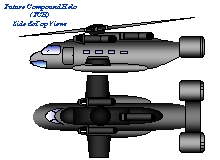
COMPOUND HELO: CH-53 type aircraft with a Piasecki-type Ring-Tail, GWT 75K-90K pounds. The concept would be to marry the three engine transmission drive train on the CH-53E to a lightweight composite SkyCrane fuselage. The tail rotor spline from the transmission would be modified to power a Piasecki-type Ring-Tail ducted fan similar to their compound helicopter "Pathfinder" test bed developed in the 1960s and other follow-on studies done by Piasecki on the AH-64 & AH-1W airframes (1980s).
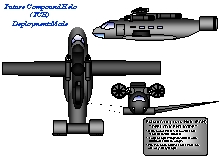
a. Deployment Mode: The main rotor blades are removed and stored internally or carried in a fixed-wing cargo plane. High Aspect ratio wings are mounted on the fuselage. The aircraft takes off as an airplane using the thrust from the Ring-Tail ducted fan powered by the three engines. No drag from a wind-milling rotor and no additional engines needed. The wings would be semitrical allowing the wings to be interchangeable. Estimated cruise = 225-300 KIAS
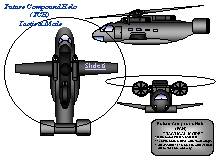
b. Tactical Mode: The long-range wings are replaced with low aspect short span wings and the rotor blades are remounted to the main rotor. Aircraft operates as a conventional helicopter. The short wings would rotate vertical to reduce downwash pull during hover and carry 25-50% of the lift load in cruise flight. This will allow a reduction in rotor load and RPM that would delay the effects of retreating blade stall and facilitate a higher than normal cruise speed of about 175-225 KIAS but with stealthy construction and ability to aggressive fly Nap-Of-the-Earth (NOE) flight profiles to evade enemy detection.
c. Tilt-Rotor Disadvantages Disqualify it: we personally favor the compound over the tilt-rotor design. Tilt-rotors involve two complete rotor systems and complex rotation of nacelles or whole wings. A drive shaft between the two nacelles is required for safety in the event of engine failure which is a real challenge concerning the flexing wing. Ship-board operations are tough because of the wing which will need to fold like the V-22 and there is always the possibility of failure in the airplane mode resulting in loss of the aircraft. The very aircraft to helicopter shape required to tilt rotors and engines mitigates against stealth technology being applied as they are radar traps. The flight profiles available to a tilt-rotor flying essentially as a fixed wing aircraft are limited to low-level terrain CONTOUR flight, not the NOE terrain MASKING flight profiles a more agile helicopter can perform.
d. Compound Helo Background: Sikorsky has done extensive work in the past on compound helos and probably has the most experience and data to date. Sikorsky's early work with compound helos such as the S-61F program of the 1960s approaches our concept but the more recent Rotor Systems Research Aircraft (RSRA) project more closely follows our proposal for a future heavy lift helo. As with the successful RSRA, the core of the idea is an aircraft that can efficiently self-deploy as a pure airplane then revert quickly to a heavy lift compound helo upon arrival in theater. The key difference with RSRA is to employ the Piasecki Ring Tail in lieu of the GE TF34 turbofans and use the power from the three GE T64 turboshafts for fuel economical forward thrust.
Another option would be to use CarterCopter (CC) gyroplane technology and use an unloaded weighted end rotor and wings with the ducted ring tail to get a hovering and V/TOL capable autogyro without the hydraulic nightmares that a powered all the time rotor faces. Helicopters are simply to complex and expensive to maintain and an Army in battle with an enemy doesn't need a huge collection of mechanics on the ground in forward bases that have to be protected from enemy attacks. A CC Future Compound Gyroplane (FCG) may be the best overall answer to U.S. Army battlefield needs for light utility/attack.
The CarterCopter Option for Helicopters
Adding the CarterCopter option to existing / future helicopters should provide the following benefits:
1. Improve operations at higher density altitudes on takeoffs / landings.
2. Double the cruise speed.
3. Triple the effective range.
4. Increase the maximum ceiling at cruise speeds.
5. Reduce the "dead man zone".
The CarterCopter option would require the following changes:
1. Install a CarterCopter-style high-inertia rotor with an appropriate airfoil.
The CarterCopter uses a symmetrical airfoil because its rotor blade at mu1 sees completely reversed airflow over the retreating blade. The same will happen to a helicopter if the rotor is unloaded to obtain the higher performance. A non-symmetrical airfoil may work for converted helicopters - but would require research to prove the feasibility.
2. Install wings having low profile drag and low induced drag. Because the wings are not used for takeoffs/landings, they can be designed for maximum efficiency at high forward speeds and high altitudes.
3. Install a way to provide thrust once the rotor is disconnected from the engine.
A. One way is to use a special jet engine like the one designed for the Sikorsky X-wing project. This engine provides high shaft-HP to the rotor for takeoffs/landings, and for hovering. The engine then provides high thrust once the rotorcraft is moving forward and converts to the CarterCopter operating mode.
B. Another way is to use a Piasecki-type Ring-Tail ducted fan similar to the one used on the compound helicopter "Pathfinder" and on the AH-64 & AH-1W in follow-on studies.
Using the CarterCopter option:
When the CarterCopter mode is engaged during forward flight, the rotor is disconnected from the engine and begins depitching/unloading. As the rotor unloads, the aircraft's weight is transferred to the wings. Once unloaded, the rotor does not (essentially) produce lift and slows of its own accord.
Rotational HP is a cubed function of rotor-tip speed. By slowing rotor-tip speed to 100 RPM, the rotational aspect of the rotor profile HP is reduced to approximately 1/27th of the rotational profile HP at 300 RPM. The rotor can safely slow to this speed because the 55-pounds of depleted uranium in each rotor-tip keeps the rotor blade stiff due to centrifugal forces (like spinning a rock on a rope).
With the jet engine (or Ring-Tail ducted fan) now producing high thrust, the helicopter is flying as a fixed-wing aircraft. This accounts for the higher cruise speeds, longer ranges and higher altitudes.
Should the engine quit, the helicopter simply auto-rotates to the ground. It stores energy in the rotor during descent by permitting the high-inertia rotor to greatly over-speed. Even with a dead engine, the pilot can pull collective when landing and use the stored energy to provide 5-6 seconds of hover.
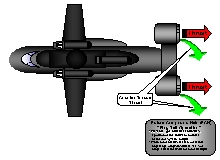
e. Low Cost: Developmental costs and time should be significantly less for a CH-53E based compound verses an enlarged tilt-rotor. A proof-of-concept prototype could be built using a modified CH-54 or S-64 SkyCrane with a pair of Ring-Tail ducted fans replacing the Tail Rotor. The CH-53E already can sling-load a 12-18 ton payload. By using the SkyCrane without a fuselage we gain 2 tons of lift. Which is easier to accomplish, building new rotor systems on an enlarged version of the V-22 or reconfiguring the CH-53E anti-torque tail rotor to the Ring-Tail design?
Future Army Option: A possible Army option is to field about 750 Future Compound Helos/Gyroplanes (FCH/FCG) to replace all 430 CH-47s and displace about 700 UH-60s assigned to air assault organizations. FCH/FCGs would be organized into independent brigades and designed to plug & fight with Light Armored Cavalry Brigades (LACB--what the 2d Armored Cavalry Regiment at Fort Polk, La would become if equipped with the M8 Armored Gun System and/or M113A3) to form Air-Mechanized Task Forces (AMTFs).
Typical Scenario: An FCH/G brigade self-deploys from California to an Initial Staging Base (ISB) in Okinawa in about 72 hours and plugs into a prepositioned LAB to form an AMTF. The AMTF conducts a mechanized air-assault from Okinawa to North Korea; an AIRmechanized "Inchon" maneuver.
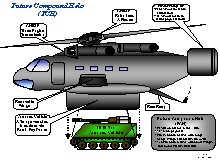
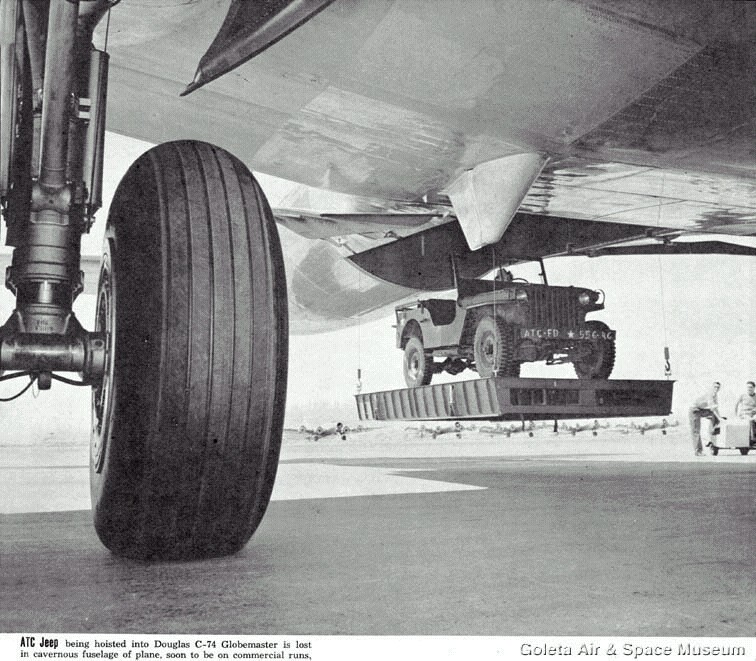
a. Displaced LZs/PZs: The Landing Zones (LZs) and HIPs are discreet areas displaced from the objective areas by as much as 40-50 kilometers. This greatly improves aircraft survivability and makes suppression of enemy air defenses easier through the exponential expansion of possible LZs. The winching and bomb-bay door or Assault POD feature of the FCH/G allows efficient air maneuver that comes with an internal load and the advantages of sling loading in delivering a payload in small un-improved/pathfinded areas where airlanding space is unavailable. The armored vehicles can be winched into tight fitting road spots along mountains or even through light underbrush from HIPs. The inserted ground force conducts mechanized maneuver to accomplish its mission and can drive to multiple discreet pick up zones (PZs).
b. AIR-MECH-STRIKE MECHANDO 2D/3D Maneuver Doctrine: The inserted battalions gain instant positional advantage from their air assault and exploit the war principle of surprise by conducting mechanized maneuver to further gain close tactical advantage. The inserted armored vehicles more closely resemble the Army's version of an Aegis Guided Missile Destroyer packed with sensors and vertically launched missiles (Enhanced Fiber Optic Guided Missiles--EFOGMs) than the current heavy battleship-type M1 tanks with their heavy direct-fire resistant armor and cannons best employed for 2D maneuvers over open terrains. Using organic UAVs, manned observation & attack aircraft, airdropped ground sensors and even satellite imagery, the ground commanders begin locating and attacking enemy armor and hidden infantry with their own vertically-launched smart munitions from 8 to 20 kilometers away or target them for attack helos, fast movers or even ship-born munitions. Enemy armor that survives these Precision Guided Munitions attacks (PGMs) are maneuvered against and dealt with by lightweight, direct-fire ("point & Shoot") Hyper-Velocity Missiles (Line Of Sight Anti-Tank--LOSATs) that deliver SABOT-type penetrators. Well rested and heavily armed infantry then dismount from other air-inserted armored 3D maneuver vehicles based on the same family of chassis/engine to complete the destruction and secure the objectives in concert with heavier 2D maneuver forces.
c. Future Land Warfare: The fruits of the alleged "information revolution" (Mental Digitalization) will not be fully realized until we develop forces that PHYSICALLY can move both strategically and tactically at speeds that can exploit the gains made in battlefield situational awareness. The Army's push to embed new digital technology on immobile Stryker trucks that cannot even fly by C-130 STOL fixed-wing aircraft much less Army helicopters does not yield us a 3D maneuver force to compliment the M1 and M2 tank-based 2D maneuver forces. Digitizing vulnerable and immobile Stryker trucks will yield only marginal tactical advantages due to their excessive weight for infantry carriers (19-22 tons) handicapping them to roads/trails where enemy land mines await in ambush and poor strategic/tactical mobility (needs massive sealift requiring days, weeks, months). However, a light tracked armored vehicle (light tank) and heavy-lift rotor-wing and ESTOL aircraft combinations can fully exploit the advances in information warfare. The Army's efforts to look for a replacement for the CH-47 is the door to which industry can demonstrate the possibilities of a truly AIRmechanized force. Now is the time to develop the computer simulations and preliminary design work to shape the Army's forth-coming Chinook replacement requirements. It would be an absolute shame if billions are poured into a beefed-up, non-stealthy V-22 that has the same or less lift performance and standard external hooks like a Chinook but only flies farther and faster! We need a lift aircraft that is designed from the get-go to facilitate AIRmechanized MECHANDO 3D maneuver warfare. We could build a CH-54/S-64 SpeedCrane in a matter of months for less than $200M.
d. UH-60/Wiesel or BV206S Stepping Stone: we have proposed like the Chief of Staff of the Army, General Shinseki, that need a "Medium" AIRMECH force NOW; not later after 10-20 tears of developing a new vehicle. Then U.S. Army Major Charles Jarnot's USACGSC thesis and AIRmech Strike XXI article in Military Review describes this "stepping stone" toward AIRmechanization we follow the lead taken by the former Army Chief of Staff and the Germans and mechanize the 101st AIR ASSAULT Division with about 500 German-built Wiesel 2 armored personnel/weapons carriers or Swedish Bv206S tracked AFVs since they can be carried by UH-60s. The Wiesel 2 is a fully tracked mini-APC that is about the size of a minivan, carries seven troops and weighs only 6,000 pounds. The new UH-60 Lima Blackhawks with their newly increased gross weight and hook limits could sling-load a fully armed Wiesel 2 and a seven man squad carried internally! The 7-ton Bv206S separates into two "cars"; so each can be UH-60L lifted. The Germans have already equipped three small Brigades with an earlier four-man version of the vehicle and uses CH-53Gs to transport them. (The Germans do not have any Super Pumas or Blackhawks). The Wiesel 2 is not large enough to accommodate the missiles, communications gear, armor protection or infantry capacity (stretched versions can carry a 5-man fireteam) to fully exploit AIRmech warfare but would provide a significant improvement over the Vietnam-era dismounted infantry air-assault doctrine currently employed by the division. An AIRmechanized 101st Air Assault Division would be an excellent "middle"; force between our Ultra Heavy M1/M2 Armored 2D forces and our Ultra Light infantry 3D maneuver formations. The TRADOC commander recently articulated to the Chief of Staff of the Army the real need for a middle-sized airmechanized forces in a TRADOC doctrinal pamphlet. An AIRmechanized 101st Division would also serve as an excellent test-bed to develop AIRmechanized doctrine, procedures and institutional requirements for the day when they upgrade to a 20,000-30,000 pound high-tech armored vehicle air assaulted by the Future Compound Helo (FCH).
The Delta Weapons companies could swap their pathetic Humvee trucks for either Wiesel 2s, BV206S Ridgways or 4-roadwheel M1113A5 MiniGavins---the latter would be CH-47-only heli-transportable so no change in the 101st's manning would be needed but HHC, A, B and C companies could be cross-country maneuvered as needed under armor.
PHASE II: THE STEALTHY FUTURE COMPOUND TRANSPORT HELICOPTER: MH-2000X


The "next Chinook"; could be a compound heavy lift helicopter/gyroplane with instead of a tail rotor's power loss to counteract torque, a PUSHER PROPELLER and ducting for directional control. The FCH/G would have wings so that when transitioning from hovering take-offs it would become a pusher propeller fixed wing turboprop aircraft without the risks involved with the tilt-rotor concept.
A CH-54/S-64 SpeedCrane could be made in a matter of months and then put into Low Rate Initial production (LRIP) to field a 100 heavy lift helicopter for to enable Sea-basing to avoid inflaming local populaces as land-basing tends to do, and Air-Mech-Strike MECHANDO 3D maneuver warfare. After we get this going, we might then optimize the following SpeedCranes with new design fuselages.
With compound helicopter designs everything becomes simpler and stress reduced: after 150 knots the main rotors are needed less so their loading decreases dramatically. The tail propeller is a conventional aircraft propeller with just a single shaft to turn it. Vanes duct the air to turn the aircraft left or right. No one can walk into the tail rotor. As the wings create lift speeds of 250 knots are achieved with tremendous fuel savings = longer ranges.
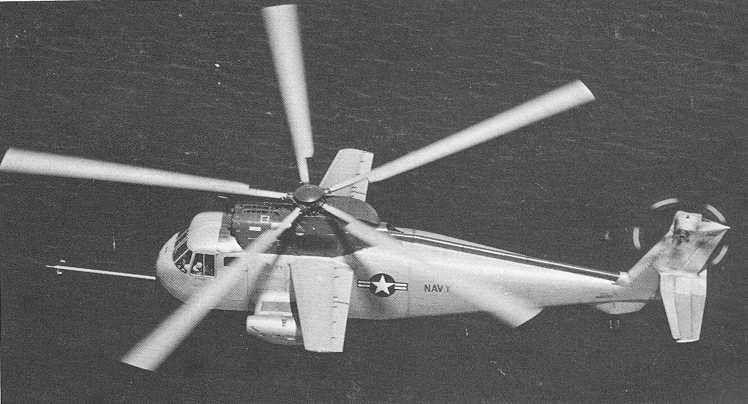
The Sikorsky S-61F Research Compound Helicopter Program sponsored by both the Navy and the Army in 1965. Two 2,900 lbs thrust Pratt & Whitney Turbofan engines on pods. 32 foot wing span. A later version had six blades.
In the '60s Sikorsky modified a S-61 (USAF H-3 "Jolly Green Giant") with large wings and a pair of turbofan engines that could upon a rolling take-off fly without its rotors entirely!. Basically if you make the wings large enough, a compound heavy-lift helicopter can fly like a turbo-prop fixed wing aircraft (300+ mph) carrying its rotors inside for inter-continental deployments to an Intermediate Staging Base (ISB). Detachable wings can be made so each wing is identical so it could fit on either side. A semitrical wing design would allow you to turn the wing over for use on the other side.
With extendable wings like used on the Gevers Aircraft Company of Brownsberg, Indiana's "Genesis" variable span amphibian, (page 536 of Jane's All the World's Aircraft, 1995-6 it would be possible to even have the rotors get shot off in combat in forward flight mode and still fly to a safe rolling landing. This is on top of the normal auto-rotation landing into any spot safety advantage helicopters enjoy. The MH-2000X compound heavy lift helicopter/gyroplane would be the safest aircraft on earth. Unlike past compound helicopters, the wings would rotate 90 degrees to stay out of the rotor down wash during hovering take-offs and landings---like a sail on a nuclear submarine busting through the polar ice cap. With a rolling take-off capability unavailable to a tilt-rotor (rotors too large to face forward on the ground), the MH-2000X can carry a FULL mission payload even in high/hot weather conditions because it doesn't have to make hovering take-offs.
A HEALTHY BODY IS A STEALTHY FUSELAGE
The low-cost way to create the next Chinook begins with the Sikorsky CH-53E Super Stallion 3-engined heavy lift helicopter (using the 4,750 shp T64-GE-419 turboshaft engines in the MH-53E) and creating a stealthy, low observable fuselage without a rear ramp streamlined back to a ducted pusher propeller. Imagine a RAH-66 "Comanche on steroids"; or "MH-53X"; or "MH-2000X". The 3-engine rotors of the Super Stallion are already proven and tested and can lift 36,000 pounds (18 tons)--imagine if we lightened the fuselage by using a SkyCrane or lighter materials---2 tons of more lift. Now we have a platform that can fly behind enemy lines with confidence, speed, range and M8 Buford AGS light tanks in the force.
THE HOVERING INSTERTION/EXTRACTION PROBLEM
One of the myths exposed/corrected at Pathfinder School is that helicopters can just land anywhere--ones or twos maybe, but to get any tactical value several aircraft must land at once to get a rapid build up of combat power, not piecemeal. As you will note, the MH-2000X has no rear ramp. Instead it has a bomb-bay floor that lowers itself rapidly by cables to deliver vehicles, PLS flatracks, and men at a hover, so the aircraft need not have to fit to land. The CH-54/S-64 SkyCrane has a powerful winch to effect this capability. Or a POD system can be used so units can pre-load "mission packages" without tying down aircraft and wasting time waiting for the aircraft to arrive. Obvious open Landing Zones (LZs) can now be avoided. A smart enemy like the VC/NVA leaves sentries at key terrain to warn of aircraft troop insertions. Most importantly, aircraft can now hover-insert armored fighting vehicles like the plentiful 11-ton M113A3 Gavin without having to sling load, and from higher hovers at a designated Hovering Insertion Point (HIP). This means the MH-2000X can fly without the drag and risks associated with sling loads to fly fully aggressive nap-of-the-earth (NOE) profiles to dodge enemy defenses. If Paratroops/Rangers are inserted by the bomb-bay floor, they can face out and fire their weapons on the way down, landing as an intact fighting unit instead of ones or twos from a rope. This is very important when assaulting defended rooftops in a rapidly urbanizing world.

It gets even better--not only can vehicles now drive onto the lowered floor and be winched up, so can Soldiers be recovered after a recon mission without having to dangle from a rope like in STABO, SPIES and FRIES.

Troops enter the aircraft via side doors with ramps that can be used to roll on/off human powered vehicles like bikes and carts or jumped from when the ramp/doors are opened or removed. With a wide wedge-shaped fuselage, the MH-2000X should be able to land on the water to recover SEALs and SF swimmers perhaps through a larger left side cargo hatch. Depending on the complexity desired, the MH-2000X can have its landing gear extend to load vehicles and/or a special ground loading ramp would be used to roll it up onto for loading. If the POD system is used the pods would have spar rails which can be reattached from a hover and brought back into the MH-2000X. Another option would be to have the nose of the MH-2000X open up C-5B Galaxy-style for pod loading. If the landing gear doesn't kneel/extend, the MH-2000X could come to a hover and load the vehicle(s) and settled back down for tie downs etc. If the bomb-bay feature is broken, a cargo hook for regular sling loads would still be an option.
TRACK-WHEELS: THE BETTER WAY TO LAND
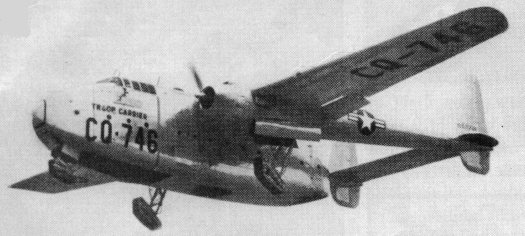
Air-filled tires go flat and lack traction--they can also simply sink into soft mud, miring the aircraft. The MH-2000X would have two long sponsons along the fuselage holding a recessed mobil-trac type track-weels like used on the U.S. Army ESMB trailer. There would be no nose wheel to dig into soft soil. The MH-2000X would be like a tracked vehicle with a skid wheel in the tail in event of a hard put-down landing like the Apache and Blackhawk's tails. These tracks would be rubber and free moving for running take offs and landings and for extremely low ground pressures for soft soil operations. The tracks can be removed for the 12 wheels to roll, each is a foam spongy filled tire --solid with no air pressure to go flat like we used on our militarized all-terrain bikes for Operation DARK CLAW. The APU would power the front wheels for the MH-2000X to propel itself over the ground slowly by pilot or crew chief walking ahead with a remote control for tactical parking. The MH-2000X would have rotor brakes and folding via the CH-53E components so the entire aircraft would fold up like a moth to be moved from the open LZ to a hidden woodline or camouflage net for dispersed parking, or land on ships.
SELF-PROTECTIVE SMOKE SCREENS
Each MH-2000X would have the ability to lay their own smoke screens via fuel directed onto their 3rd engine's exhaust like armored vehicles do. Smokescreens laid on the flanks of landing zones can defeat optically aimed small arms and shoulder fired infared missiles as smokescreen systems are now being pursued vigorously on U.S. Army/Air Force ground vehicles. Helicopter smokescreens would have prevented helicopters being shot down during recent battles in Grenada, Panama and Somalia.
AIR-TO-AIR REFUELING: STRATEGIC REACH

With an extendable air-to-air refueling probe, the MH-2000X can fly indefinitely from any spot on earth to power project AIRMECHanized U.S. Army Air Assault forces, or SOF. Utilizing AFSOC MC-130P tankers the MH-2000X can project globally or regionally using its own drop tanks mounted conformally on the landing gear sponsoons. Imagine a 173rd Airborne Brigade from Vincenza, Italy flying to Africa to retrieve American hostages long before the ship-based meu can even get loaded like what took place recently using AFSOC MH-53J Pave Low III helicopters. Unlike the Osprey force, the heavy lift MH-2000X carries an AFV equipped force that has the firepower, mobility and overmatching MECHANDO shock action to win hands-down instead of foot slogging at best even against more numerous third world country foes. The 1-508th Red Devil Paratroops could parachute in by C-17s or C-130s to secure the airport as the MH-2000X force flies in to the embassy and/or designated collection points to shuttle the American citizens to the airport for long range jet flights back to CONUS.
PHASE III: JET-POWERED TRANSPORTS THAT BECOME HELICOPTERS: THE SPEED CRANE WITH MISSION PODS
INTRODUCING THE SPEED CRANE OR POWER SLED CONCEPT:
Animated depiction of Pod system in action
Loading pods into MH-2000X Lowering pods from MH-2000X while at a hover
We hope to build a 1/42 model. We call it the "Speed-Crane" or the "Power-Sled" concept. The basic idea is to build a fuselage shaped like a rectangular sled with a 6 blade counter-rotating rotor in the center equipped with 6 retractable blades. The rear would have two large turbo-fan/turbo shaft engines. A pair of swing wings (like an F-111/F-14/MRCA Tornado etc.) and large 12 foot stork-like landing gear. The top of the fuselage will have a retractable door like a pencil carrying box that will roll up revealing the sunken rotor system. Hydraulic press will elevate the rotor and the blades would start to rotate then extend as rpm stiffening took effect. The forward part of the fuselage would have a compact cockpit with a rear set of seats for additional crews or mission specialist. The height of the fuselage would only be about six to eight feet and would provide a lifting body shape at high speeds.
The idea is to build a power sled and attach mission designed tubs or "pods" below! Small, medium and large.
The small one would be about three feet thick and carry extra fuel for self deployments, anti-sub gear, phased-array radar panels to replace the E-2C Hawkeye AWACs, or even standoff weapons for attack missions.
The medium size tub would be for light cargo, & personnel and be about six feet to eight feet tall, equipped with a back ramp which the marines love and side jump doors for Paratroopers. All 3 doors could also be used rappelling and fast roping Air Assault operations.
Then the Large tub for carrying an armored vehicle for AIRmechanized operations.
The tubs would be light weight and inexpensive since the only need to carry weight suspended from the fuselage and not have to meet the rigors of acting as a fuselage as well like the CH-47 & 53 cabin areas must do. A lightweight fiber outer panel would provide the streamlining and a basket like floor suspended on light weight cables provide the vertical strength. No need to tackle the fuselage torsion and twisting of an aircraft, the upper sled takes care of that.
The concept of a pod or tub is proven with the CH-54 SkyCrane and was once considered by the USAF with the XC-120 using old piston engined technology. General James Gavin in his visionary masterpiece, "Airborne Warfare" advocated pod-equipped aircraft for U.S. Army Airborne forces. A science-fiction TV show in the early 60s called "Thunderbirds" had a pod-equipped aircraft called "Thunderbird 2" which was THE most critical part of the international rescue operation because its versatility/flexibility allowed it to instantly load the needed rescue pod and fly directly to the scene of the crisis. ISO Container "Battle Boxes" should also be a carry option.
It worked in the past! It will work even BETTER in the future!
Self-deployment could be done in the pure airplane mode at USAF jet transport/airliner speeds (450-550
Knots) with excellent fuel economy! though air-to-air refueling capability would be organic...The SpeedCrane aircraft could slow down to hover like a helicopter for Air Assaults or drop Paratroopers from the medium sized mission tub. Pre-packaged tubs could be pre-positioned by the user in quantity for rapid deployments or link up at an Intermediate Staging Base. The mission tubs or "Battle Boxes" could be tailored to meet any service need and since they are inter-changeable could provide for excellent operational efficiency by allowing maintenance to manage a fleet of sturdy sleds that are weather resistant for outside storage vice separate specialized relatively fragile aircraft! Each service could work with various subcontractors to develop their mission tubs without the aircraft! So developmental time and thus expense would by quick and inexpensive compared to today's methods.
LTG Gavin's KIWI Pods: Thunderbirds TV Show Example
The same sled and crew could attach various tubs and thus replace the P-3 Orion, E-2 Hawkeye, Seahawk
ASW, Super Sea Stallion Anti-Mine warfare ship to ship replenishment at sea, search air rescue, anti-ship and ground strike! The only mission it could not perform
is fleet defense as a fighter or air superiority machine. A future aircraft carrier would only need the Speed Crane and a fighter, thus this could be a joint Army/Navy project with USSOCOM sure to be interested. The compact size of the sled configuration lends itself to ship storage and stealth technology application.
We estimate the sled would weigh about 50,000 lbs, be able to cruise at 450-550 knots for 2,000 miles on internal tanks and 5,000 miles on a small fuel tub. The swing wings could be removed in theater and high efficiency non-retractable blades installed if the sled were to be tasked to perform lift missions with short range requirements like Korea. Or it could have a lighter weight fixed wing installed and a passenger only tub with no winch for civilian commuter roles. Such a civil aircraft could carry 40-60 PAX across the U.S. at airliner speeds and land on roof tops or service smaller cities without the need for a airport. A larger tandem rotor sled could carry 200 PAX plus and fly overseas! Landing vertically!
THE AIRMECH CONSORTIUM: EXPLOITING VICTORY
To make these dramatic changes a reality we propose that a consortium of heavy lift aircraft makers, AFV makers and the 101st Air Assault Division be formed to finalize the requirements of the next Chinook. We are convinced it should be a CH-53E-based compound SkyCrane helicopter NOT a tilt rotor.
Sikorsky, makers of the Super Stallion, Erickson SkyCrane who own the rights to the S-64/CH-54
SkyCrane and Piasecki--who happen to be the experts in compound helicopter design would be contacted and joined together to build a prototype SpeedCrane within 12 months for $200M for Phase I. This should be followed by 100 SpeedCranes at about $20M each. Phase II would be the MH-2000X prototype. This synergism of brain power would insure we get an aircraft that can lift ALL OF the Army's equipment up to 15-20 tons, and that armored vehicles to exploit this mobility are created.
We can begin by a "Louisiana Maneuver"; where an Infantry Company of the 101st Air Assault Division is reorganized with permanently assigned Blackhawks and Wiesels or Bv206Ss, some with EFOGMs/LOSATs and a notional UAV unit be fought at NTC as an OPFOR augmentee. This would show
the awesome capabilities even an AIRMECHANIZED capability would provide. This would enable the 50-pound Javelin "fire and forget" ATGM to be fully exploited via vehicle mobility.
Next, a Battalion's worth of 60-80 German Wiesel 2 3-ton tracked AFVs or BV206S Ridgways or M113A5 Mini-Gavins would be provided to the 101st's designated Battalion's Delta weapons companies to test a surrogate FCS/Air Mobility Vehicle (AMV) using Blackhawks to move them as an AIRMECHSTRIKE demonstrator until the Chinook replacement comes online. This would utilize regular sling-loading techniques and equipment until a conformal aeropod system for carrying vehicles closer to the Blackhawk is devised. The 82nd Airborne Division would receive a battalion's worth of M113A3 Gavins and M8 Buford AGS light tanks to be their airdropped AIRBORNEMECHanized capable force--one Delta Weapons
company in one battalion in their three 3 Ready Brigades. This would be our interim AIRMECHanized MECHANDO capability in the U.S. Army until the SpeedCrane and MH-2000X comes online to lift full-sized M113A3/4 Gavin and M8 Buford AGS light tanks and the FCS/GCV-L. We can ill afford to do without these capabilities in a rapidly changing world, where these troops could fight anywhere within 18 hours.
The FCS/GCV-L should be a light tracked tank that is air-droppable and air assault transportable by the MH-2000X
to supplement the M1 Abrams and M2 Bradley series 2D forces. The M113A4 Gavin should be built with advanced lightweight armor construction as the objective Air Mobility Vehicle (AMV) in either an armored infantry "fighting/carrying female tank role" and "fire support male tank role" configurations. One way to achieve this is, is by an all-composite Armored Hull which in 1985 at Baltimore, Maryland a M113 was field tested with an experimental composite hull for future amphibious vehicles (see below). The hull is reinforced plastic covered with ceramic tiles which provides greater combat protection without an increase in weight. There are many applique' armor packages that can be added to the existing M113A3 Gavin light tank to achieve RPG/auto-cannon levels of protection via conventional materials.
There is a slowly growing ground swell among some senior officers to explore AIRmechanization, in part due to the efforts of the German Army. The future of maneuver warfare is in AIRmechanization and bravo to the corporation that postures itself to built the aircraft and light tracked AFVs that will make it happen.
FEEDBACK!


